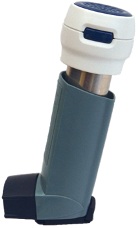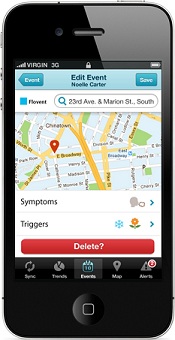In 2009, the CDC reported that one in 12 people had asthma, up from one in 14 in 2001. It's the fifth most expensive condition to treat on the list of chronic illnesses. The numbers continue to climb, and while the understanding of the disease itself has grown, the reasons why more people are developing it are not clear to researchers. Helping to manage the disease on the personal and public health levels is Asthmapolis, a three-pronged approach to the tracking and management of asthma. It consists of a GPS-enabled sensor, an app, and personalized reminders for users to take their medicine while allowing their health care providers to monitor their progress in nearly real time.
The Asthmapolis sensor goes on top of an inhaler. When the inhaler is used, the GPS system tracks the patient's location as well as when and how many times it is used during a day. This information gets stored via Bluetooth on the person's smartphone or personal computer and sent to the doctor's office for review. The user then receives a weekly summary of where they were when they had to use the inhaler, and suggestions for adjustment to keep their asthma under optimal control.


Healthcare providers get a real life snapshot of a patient's inhaler usage thanks to the information provided by the sensors. They can remotely monitor inhaler use, and use the information to determine which medications and dosages will do the best job of controlling the patient's asthma. In turn, this helps to keep the costs in line. It's estimated that uncontrolled asthma costs $56 billion in treatment a year. Keeping this disease under control saves on unnecessary doctor and emergency room visits, as well as hospitalizations.
In addition to being a useful tool for patients in tracking and treating their disease, the company also has the goal of providing comprehensive, objective data for epidemiologists and public health researchers. Asthmapolis provides data on patient compliance, most common triggers, work and school absences, and information on visits to medical facilities that are related to attacks. Thanks to the mapping system, the researchers can see where and when attacks are triggered as well as the patients' reports of what they felt started them. Some of the projects that the company is involved in are identifying environmental triggers in a major metropolitan area; mapping and assessing patients in the rural Midwest; and assessing the impact of air pollution on children living with the disease.
Asthmapolis has received international coverage in tech blogs and publications such as Le Monde, Der Speigel, and The Economist. They've been featured in trade shows and conferences, including HIMMS in Las Vegas this past winter and the American Thoractic Society Conference in San Francisco last May. This September, they will be on exhibit at Stanford University's Medicine X conference in San Diego.
Fran Jablway
and
Hulet Smith, OT